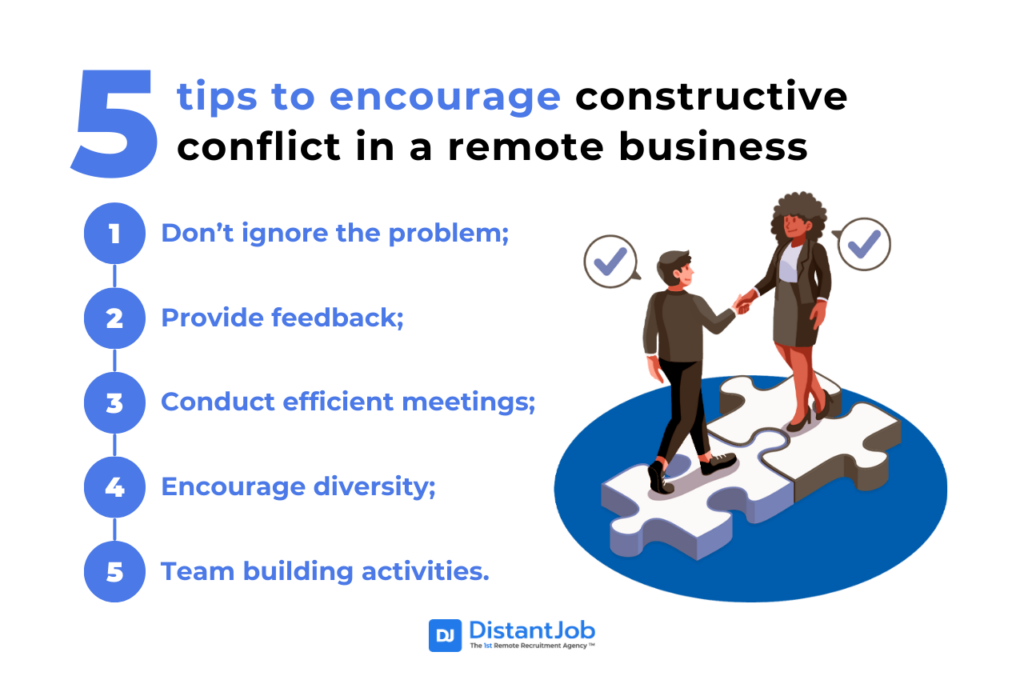Promoting conflict? Those two words together sound nonsense. The concept of conflict is usually given a negative connotation, especially in an office environment, where leaders prevent conflict instead of encouraging it. Yet, not all conflict is bad, and sometimes it’s even necessary. It all depends on what type of conflict you are promoting. For instance, constructive conflict has proven to be a great way of making teams open their minds about different realities and points of view, creating highly collaborative and diverse teams.
In a remote work environment, where most teams are diverse, promoting constructive conflict encourages creativity in teams defying each member to think outside the box.

What is Constructive Conflict?
Conflict refers to an active disagreement between people with opposing opinions or principles. Constructive conflict refers to the type of conflict that has the purpose of embracing different ideas and worldviews. Teams frequently have strong disagreements when working on a project or something relevant to the company. However, when leaders know how to manage these situations, conflict transforms into a healthy and intellectual debate on how to make things better.
This is where constructive conflict is so valuable: it provides teams with a space to be honest and speak about what they think regarding a specific aspect.
Constructive Conflict Definition
Constructive conflict is encouraged in organizations that want to increase their productivity by inspiring their employees to think differently. It’s not about who is right or who is the winner of the discussion. It’s about understanding each other and making a decision based on what is stated by different team members.
Characteristics of constructive conflict:
- Focuses on issues
- Cooperation
- Commitment to the resolution of the conflict
- Respect for others (Listening to other team members – accepting that they think differently)
- Open communication and honesty
- Encourages all team members affected by the conflict to speak up
- Promotes self-awareness
Constructive Conflict in the Business Environment
Constructive conflict in the workplace can take two forms: Destructive or constructive. To understand these concepts better, we offer you these constructive conflict example:
Imagine this hypothetical situation (this happens more than you think): You are working for an important client on developing software for their business. Everything looks good, and the team is in sync. However, suddenly your team faces a significant decision, and everyone seems to have different opinions. A week passes by, and you still can’t reach a final decision. Suddenly, the leader calls everyone to the meeting.
Case scenario A: The leader begins the meeting by emphasizing that you all need to reach a decision. Then a coworker starts discussing with another coworker, and the peaceful discussion turns into an offensive reunion. The leader starts screaming at the team that they are all incompetents. Then he chooses someone from the team to be in charge of the project and that no matter what decision they take, everyone has to obey because otherwise, they won’t be able to meet the client’s deadlines.
Case scenario B: The leader calls everyone to the meeting room. He begins the meeting by saying that you have deadlines to meet as a team, and it’s important that everyone reaches a common decision. He says that before everyone starts discussing, all of you will have the chance to speak and listen to others. After everyone finishes sharing their opinion, the leader puts all the common points together and the main differences. Everyone can see a broader picture of the problem, and the meeting ends having a greater plan of what to do next.
Case scenario A is the perfect example of destructive conflict in the workplace, while case scenario B shows how constructive conflict looks in business.
When leaders can manage their teams efficiently, they can conduct this type of meeting where the team members not only speak up about their different opinions, but they are also able to get creative, building innovative strategies and ideas.
Constructive conflict vs destructive conflict

How do You Promote Constructive Conflict in a Remote Business?
Remote work is the present. The pandemic has forced many old-school businesses to change their structure to survive. Nowadays, people are seeking more than ever the opportunity to work remotely. According to the State of Remote Work by Owl Labs (Covid-19 edition), 77% of respondents agree that after COVID-19, working from home would make them happier; and 75% of people are the same or more productive during COVID-19 while working from home.
Managing a geographically dispersed team has many benefits; however, conflict still arises, and it’s up to the leaders to handle these situations efficiently. Encouraging constructive conflict in a remote environment consists of fostering diversity and building spaces for teams to listen to each other. Leaders should be able to manage conflict in a way that, although there are many different opinions, everyone gets to talk, listen to others, and reach a common point.
Here are 5 tips to encourage constructive conflict in a remote business environment:

1. Don’t ignore the problem
If you are in a virtual meeting and start noticing patterns indicating that your team is having internal problems, don’t ignore them. Some leaders think it will all be over by ignoring them, but this usually aggravates the problem.
Encourage everyone to speak up and be honest about their opinions but also be respectful. If you think it’s necessary, schedule individual meetings and try to understand everyone’s points of view.
2. Provide feedback
Feedback meetings are incredibly important in a remote team. You don’t get to see your team in person, and because of this, it’s expected that some team members will eventually feel lonely or left out. If you see someone being closed-minded to other opinions or aggressive, arranging an individual meeting with this person will help him/her understand their mistake.
Feedback meetings aim to let employees know what you think of their performance. This means making them aware of their mistakes and providing tips/strategies that could help them improve. If they are doing a great job, it means letting them know that you are aware of how valuable they are.
3. Conduct efficient meetings
Conducting efficient virtual meetings is also essential to encouraging constructive conflict. Virtual meetings are not monologues where you talk and say what everyone should do; they are also spaces to listen to each other, find out what everyone is up to, or ask for help with something.
You can encourage debates and brainstorming sessions to listen to everyone’s opinions regarding a project, for example. The idea of conducting efficient meetings enables every participant to share their opinion.
4. Encourage diversity
Diversity in a remote environment doesn’t necessarily mean hiring employees from different backgrounds, cultures, and countries. It also means having different opinions. Encouraging diversity makes employees feel that they are heard, that their opinions are valuable. You never know if you have an Einstein in your team if you don’t give them the chance to express themselves.
Encouraging diversity is also about rewarding creativity and innovating ideas. Most people are scared of speaking up because they feel that conflict is a threat when it could be an opportunity to create even greater things.
5. Team building activities
Constructive conflict or any conflict can be easily solved when teams are connected. If teams are disconnected and only talk to each other when they need something, when a dispute arises, they don’t try to understand the different opinions. Also, being in a remote environment makes it harder for teams to connect if they are not encouraged to do so.
Virtual water coolers are the perfect excuse for them to get to know each other and make stronger relationships despite their differences. Activities such as gaming nights, virtual coffee (or happy hours), or just simple slack conversations make a big difference.
No one said management is easy. It requires commitment, vision, and passion for what you do. In remote teams, you can have great results if you implement the right strategies and techniques. If you are still unsure how to manage your remote team properly, DistantJob can help.





